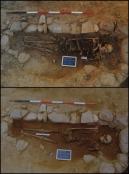CAMPAGNA 2019 |
1° SETTIMANA |
2° SETTIMANA |
3° SETTIMANA |
4° SETTIMANA |
5° SETTIMANA |
6° SETTIMANA |
7° SETTIMANA |
8° SETTIMANA |
9° SETTIMANA |
10° SETTIMANA |
01 LUGLIO 2019 
Resoconto della giornata di scavo
Area 6000
Settore Nord
La rimozione del riempimento US 6504 all'interno della tomba a cassa USM 6123 ha permesso la messa in luce di un individuo in connessione anatomica, orientato W-E e deposto supino nella porzione nord-occidentale del settore. L'inumato, un maschio con un'età compresa fra i 45 ed i 55 anni, si presenta complessivamente in uno stato di conservazione non molto buono ed è in parte intercettato, a nord, da una fossa sepolcrale di epoca successiva. Il cranio di USK 6515, ben preservato, è in apparizione frontale, l'arto superiore destro è disteso con la mano sul femore, mentre il sinistro, in gran parte asportato dall'altra tomba, doveva essere leggermente flesso sul pube, come confermerebbe la posizione della mano. Ad ovest della cassa litica è quasi completata la messa in luce degli inumati USK 6516 e 6525, entrambi orientati W-E e deposti in decubito dorsale; in particolare USK 6525, più a nord, intercetta gran parte del lato sinistro di USK 6516. Per quanto riguarda la porzione meridionale del settore, più ad ovest si procede con l'esposizione dell'individuo adulto mal preservato USK 6522, mentre ad est la rimozione del riempimento US 6519 sta mettendo in luce una situazione piuttosto complessa, caratterizzata dalla presenza di numerose ossa sparse sistemate al di sopra del corpo di un individuo sottostante in connessione anatomica, che sarà esposto nei prossimi giorni.
Settore Sud
Una volta che l'area è stata riportata in luce ripristinando i livelli esposti durante la precedente campagna di scavo sono stati messi in luce i primi riempimenti sepolcrali oggetto di indagine. Questi (US 6242, US 6248, US 6250) si situano sull'asse est-ovest dell'area dalla facciata al limite occidentale. US 6242 sta rilevando un individuo (USk 6240), a ridosso della tomba a cassa USM 6194, molto frammentato ed in precario stato di preservazione. Non sembra avere un contatto diretto con la suddetta struttura, indice di probabile posteriorità rispetto ad essa. Il riempimento US 6250 sta invece restituendo USk 6251, maschio adulto in apparizione sinistra e dai piedi accavallati, probabile testimonianza di un sudario presente al momento della sepoltura. Al centro dell'area il riempimento US 6250 è stato completamente rimosso esponendo l'individuo USk 6253, donna di età compresa tra i 40 ed i 45 anni, orientata est-ovest, priva del cranio a causa di successivi tagli sepolcrali e deposta a brevissima distanza dalla tomba a cassa USM 6062. Il taglio in cui tale sepoltura è stata deposta, US -6254, ha intercettato a livello degli arti inferiori uno strato di pietre relativo alla realizzazione della sopraccitata tomba a cassa. Lo scenario verosimile vede gli operatori scavare la fossa sepolcrale in prossimità della precedente struttura ed interrompere lo scavo in profondità nel momento in cui si trovano a dover scavare il livello di pietre che costituiva il sacco di colmata tra la parete sud della cassa litica ed il taglio per la creazione della stessa.
Area 6000/A - In the Northwest grave we widened certain areas of the burial. The femurs of the burial currently being excavated are beneath the stones of the lithic coffin indicating that the burial is older than the tomb itself. We then focused on the thorax for the two burials present in this sector. In the northeast sector we finished cleaning the grave to define the wall of it and the grave itself was photographed. After that they began to expose the bones of the older individual in the grave. In the southwest section the vertebral column was further exposed to reveal potential pathological conditions. In the southeast grave more scattered bones were continued to be revealed along with a grave good of some kind. It was a metal piece that vaguely resembles a belt buckle.
Area 6000/B - Today, from 8:30 to 11:00 and 2:00 to 5:30, we continued to clean the uncovered area and removed the top layer of new sediment. Multiple bones were found, including teeth and multiple long bones. Fragments were also found in the fill. The mandible and fragmented skull of a child was also found in the area. Glass, ceramic sherds, and bricks were found as well. We also brushed off the stones making up the wall and tombs. In one section of the area, a defined rock field indicating a potential area for further excavation was also found. We will continue to clear the top layer tomorrow.
Area 7000
We identified a rather complex situation in the northern portion. Here it has been identified what appears to be the residual of the eastern European capital is preserved, immersed in a layer of gray-colored mortar. On the north-eastern corner of the structure made of clay mixed with lime, very compact, called US 7006. This was later cut from the lithic box tomb already investigated in the previous excavation campaigns in the 6000 area. chronological sequence of these three archaeological evidences given the US 7006 layer,
Still, the removal of US 7011, a layer of modern formation characterized by the presence of fragments of small stones immersed in a clayey matrix, allowed to highlight a trace of thermotransformation of the semicircular ground in ancient times.
Today began by quickly brushing the area. Next, markers were placed in order to take pictures of the area. GIS points were taken as well as photographs. Then, the area was pickaxed to expose the layer underneath. In this new layer many ceramic pieces were found. Also found were a few nails, some animal bones, many bricks as well as mortar, a small sheet of metal about 2 cm long, and more pieces of cocciopesto.









